Kristen suggests that white’s issues aren’t card draw or ramp – at least not entirely. The problems arise from how little tempo it can generate.
Historically, white has struggled with ramp and card draw when it comes to EDH. It’s entirely reasonable that this would be the case if you examine how the colors interact in 60-card constructed Magic.
Red and white burn fast, and they burn bright. They aim to take a game before other colors can establish a foothold, and they do it by keeping up the pressure and whittling down life totals at speed. This doesn’t exactly scale to Commander, a format which uses the same pool of cards, but sets life totals to 40, and requires you to burn through three of those 40s to win.
When you add in the fact that your cards are worth ⅓ of what they usually are, and that your opponents collectively will draw three times as many cards as you do – before factoring in any draw outside of the draw step – it starts to become obvious that red and white have suffered.
Red is Fixed
Red, in many ways, is fixed. It can generate more card advantage by “impulse drawing” (exiling cards from the library to play within a set amount of time, usually until the end of the next turn). It can also generate mana using rituals, and it can amplify damage.
The neat part about amplifying damage is that it scales well with your deck. A Commander deck is way more midrangey than a Standard or Modern deck, and so tripling the damage of four-, five- or six-drop creatures in a 40-life format is roughly equivalent to amplifying one- and two-drops in a 20-life format. This is a perfect example of how modern card design balances between 1v1 and multiplayer Magic, and is also a great example of how red is “fixed”.
It’s a lot harder to do this for white outside of supplementary products, because the things white does best – hindering through taxes, playing efficient bodies, and using fixed buffs – are way more difficult to scale on one card designed for multiple formats. It’s also potentially pretty unfun; tripling taxes sounds horrid.
White Isn’t That Broken
I could go deeper on that analysis, but that risks us getting off topic, so back to white.
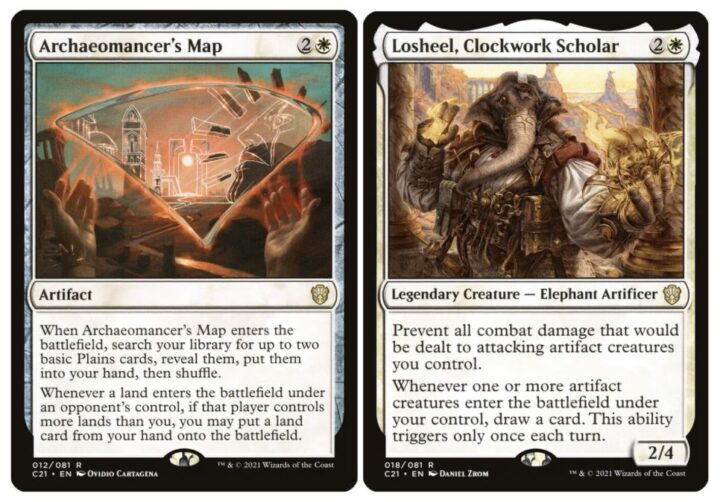
While it has suffered in the past, there is a lot being done to bring white up to speed. Archaeomancer’s Map single-handedly put white back on the map, and Losheel, while limited to once per turn (ugh), shows a willingness to put multiple forms of card advantage on one cheaper creature. White has options when it comes to ramp, with mana rocks, “catchup” cards like Keeper of the Accord, and tutoring lands to make land drops, such as with Gift of Estates. And, in the great words of Han Solo: “Hokey religions and ancient weapons are no match for a good Sword of the Animist by your side, kid.”
Drawing cards, on the other hand, is still a little tough and conditional. While Mangara and Losheel both let you draw cards, the former is quite conditional. A lot of white’s card draw is tied to lifegain or tokens, so if you want to build a deck that doesn’t at least dip into those avenues as a subtheme, you’re kinda screwed.
EDH is All About Tempo
So, the main reason white needs to be able to ramp and draw in Commander – unlike in 1v1 formats – is to keep tempo with the other decks at the table. I’ll say now that this entire article is aimed at non-cEDH Magic; if you want to Stax out the table, be my guest. For white to succeed in casual settings, it instead has to play more similarly to the other colors. This has been an evolution of how EDH is played, and how cards are designed, and is a work in progress by all means.
Casual EDH is all about tempo, and that’s why cards like Bolt Bend are in vogue right now. It’s a huge tempo swing to spend a single mana on not only foiling an opponent’s plan, but removing a key threat. While this is another topic I could again delve deeper on, I’ll leave it at this: as games move toward ending in 6-8 turns (versus 8-10), cheap blowout interaction is the fastest way to gain tempo while protecting your board.
I’ve mentioned previously how board wipes have to be cheap or asymmetrical to be worth running these days, and so I’m glad to see Vanquish the Horde and By Invitation Only printed. Most of white’s board wipes are symmetrical and expensive, and so its one niche – being the color of removal – is kinda lagging.
So, if EDH is about tempo, how does white currently gain tempo? Well, other than Teferi’s Protection and Akroma’s Will, white has few true ways to swing tempo, and they almost all involve combat. Cards like True Conviction, for instance, are great anthems, but prone to blowouts. Even Teleportation Circle, which is on the right track, requires multiple permanents to function.
Speaking purely in the realm of interaction, indestructible isn’t what it used to be. Most single target removal is bounce or exile, and many of the better wraths right now are -X/-X or edict-based. So, outside of Teferi’s Protection, white’s realistic suite of answers is way too focused on indestructibility when that isn’t the battle it’s fighting. This wouldn’t be much of a problem if it weren’t one of the main arguments used against giving white more draw; the argument tends to go that “white should protect its investments, that’s how to gain card advantage”.
Guardian of Faith and Glorious Protector do seek to solve this, but they don’t fit in every situation – or, indeed, every deck. Guardian leaves you wide open to being swung at, and Glorious Protector does nothing for Angel tribal decks, or decks that top out with Angels – which is quite a lot of white decks.
Explosiveness, Measured
What I’ve covered so far is how decks can gain tempo by swingy, blowout-style plays. I’ve also touched on the argument of giving white card advantage by using protection-based interaction to keep its board investment from going down the drain.
This is all well and good, but tempo isn’t only gained in these scenarios. The biggest tempo swings come in the form of mana advantage, drawing multiple cards, and using counterspells to trade small amounts of mana for larger amounts. While the latter is more similar to the interaction mentioned above, the others couldn’t be more different.
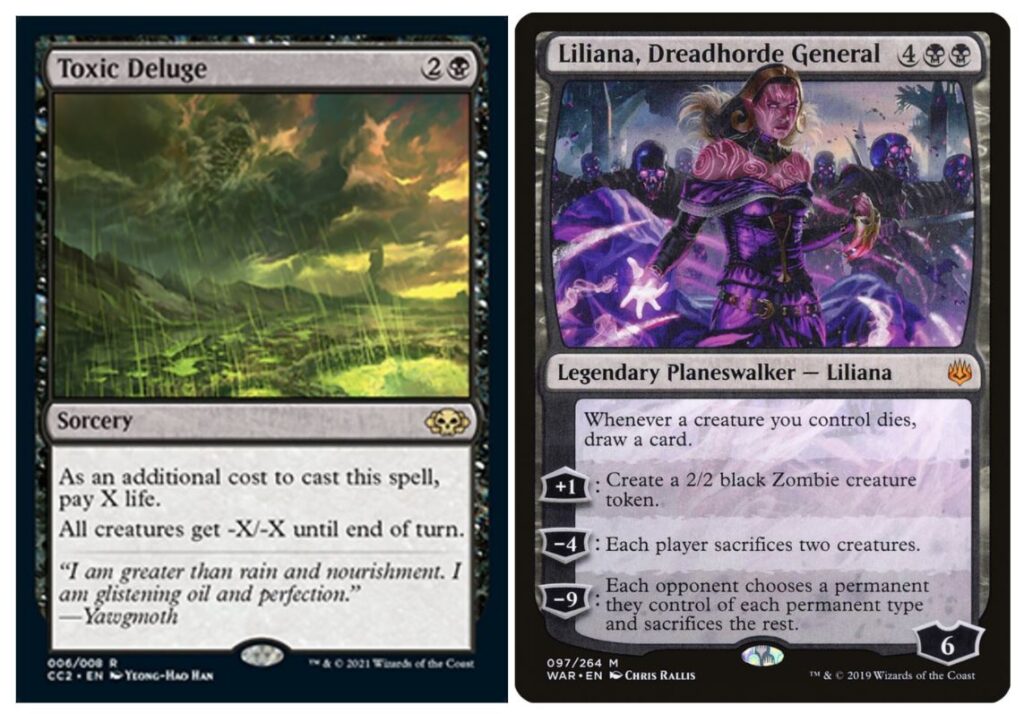
Black decks can draw a bunch of cards from creatures dying, and many of the cards printed from War of the Spark onwards allow you to do this without spending mana.

Red decks can generate a bunch of mana to have big turns. Those turns can be lengthened by the likes of Birgi, God of Storytelling and Storm-Kiln Artist.
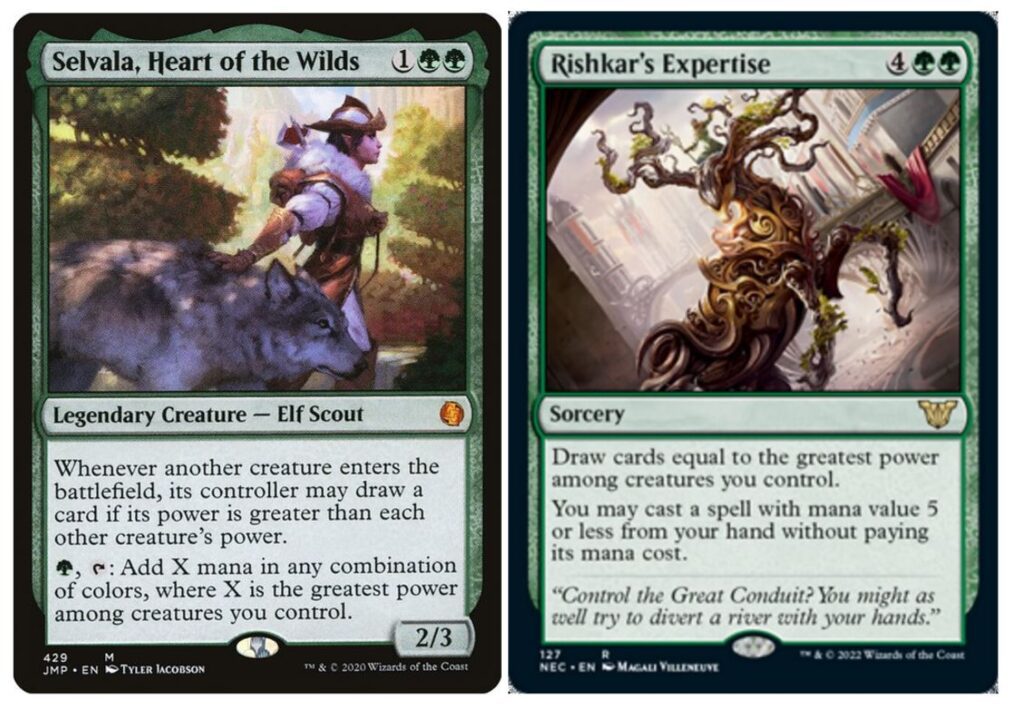
Green decks can make oodles of mana, and they can draw huge reams of cards with very little effort. I even mentioned the likes of Apex Devastator in my Underplayed 2021 Commander cards article – it lets you have one huge, decisive turn.
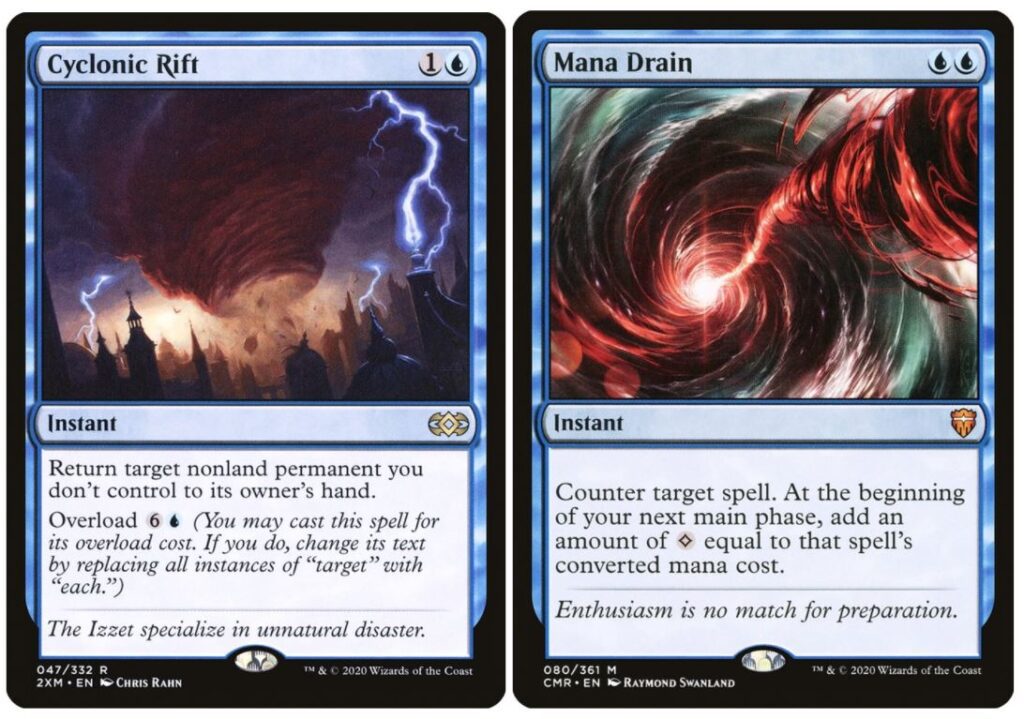
Blue even has ways to make an opponent’s turn decisive – interacting at instant speed to build tempo and cause far bigger blowouts than casting Blacksmith’s Skill or a cheeky Mana Tithe.
Having big, decisive turns is what casual Commander is about, and we measure explosiveness by how quickly a deck can go from behind or at parity to decently ahead. The other colors can manage explosive turns in many different ways, and when you begin to combine them, the potential for explosiveness is heightened significantly.
While white will always be a great support color, it struggles to stand on its own because it can’t manage an explosive turn nearly as consistently as the other colors. Sure, it can cast an Elesh Norn, but it’s usually hardcasting it. It’s far more devastating to use Animate Dead on it in the early game than to drop it late where it can be hit by single target removal – and that’s precisely the issue.
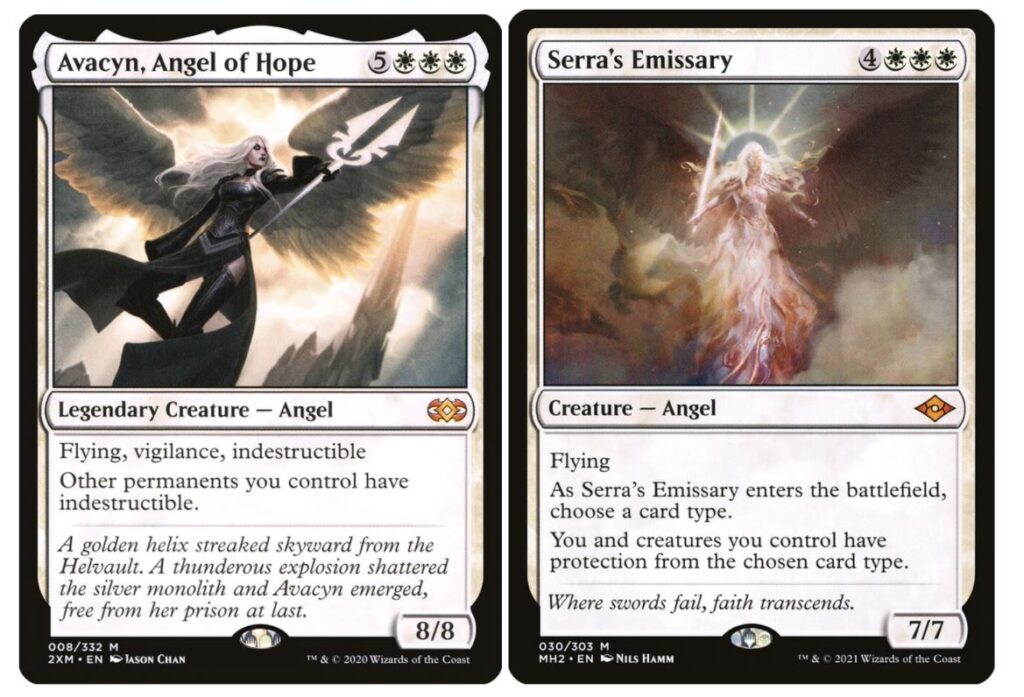
White’s current explosiveness is tied to big creatures. Everyone will throw their removal at an Avacyn, Angel of Hope, and I honestly think that that threat assessment is outdated. The problem isn’t Avacyn; she barely even converts a win, especially when mass land destruction is verboten. Most of the time, the engine piece, card draw creature, or mana dork is far more crucial to get rid of than Avacyn. It’s gotten to the point where I see Serra’s Emissary as the far superior option. It’s one mana cheaper, and aside from stopping damage wraths or single target removal, it can give you both unblockable and a fog effect if you choose Creature.
When white’s explosiveness is tied to big creatures that it can’t ramp to nearly as well as green, and it can’t always have interaction in hand because it can’t draw as many cards as blue, well… you have an issue.
Incremental Tempo
Now, again, I don’t think this is enough to leave white dead in the water. White’s lack of explosiveness can be offset by getting to slow and stymie the other decks at the table. Whether that’s viable or considered fun is up for debate, but even if that can go some way to solving the problem, it doesn’t shore up the other compounding issue.
White is very bad at gaining incremental tempo. What I mean by this is that it struggles to gain tempo and advantage by completing regular game actions. Black can kill or sacrifice creatures to draw cards, or make mana from creatures dying. Green draws off of playing creatures, and increases its mana production by playing more creatures. Blue draws off of playing noncreature spells, and can play the long game until it gets set up.
White doesn’t really get to do that, and instead has to rely heavily on Equipment to graft on the abilities it sorely needs to catch up. White also struggles in this manner because it relies on unitaskers: creatures or other permanents that have one role in a deck, but don’t otherwise contribute to a strategy. Think Stoneforge Mystic – I run it in tribal Angels to grab consistency pieces like Mask of Memory and Sword of the Animist because they let me play the tempo game. Without them, I can’t get ahead, and I’m only ever casting one spell a turn. These unitaskers also dilute tribal decks significantly; most tribes in other colors feature card advantage or mana generation, while white-based tribes like Knights, Soldiers and Angels generally have to mix things up. Whether you think that’s fun or flavorful is beside the point; unitaskers dilute white decks.
Treasure, the Great Equalizer
As white struggles to build up incremental advantage that can be swept aside by a well placed board wipe, it can fall even further behind when a player casts one of the individual cards that can swing tempo in a massive way. A Jeska’s Will or Storm-Kiln Artist or Nissa, Who Shakes the World can feel devastating if you’ve missed a land drop or couldn’t ramp when playing white.
Dockside Extortionist is another of these explosive cards, and there’s no better deck to play this wily pirate against than a mono-white deck: a deck replete with many artifacts and enchantments that it has to assemble to gain card and mana advantage, usually at a far higher mana investment than in other colors.
It disappointed me immensely, then, to learn that Treasures are now decidedly out of the running for white going forward. Nobody can deny the impact Treasure has had on the format, and I could write an entire article on just that subject. Suffice to say, taking another explosive thing away from white doesn’t do it any favors. As much as people complain about Smothering Tithe, it does what white needs – reduces the number of spells each player can cast per turn. If players are too selfish to pay the tax? Well, white then gets to cast more spells per turn, which balances out in a similar way.
White Lacks Enabler Commanders
Because white can’t do anything en masse, it can’t get ahead – but worse than that, it also can’t catch up. Explosiveness might well be the main way decks can break parity, but it’s also instrumental in letting decks catch up when they’re behind.
With white being in the unfortunate position where it can’t be explosive, when it loses, it can really feel like bad beats. This is exacerbated by the fact that white doesn’t really have explosive commanders, either, which is especially problematic at tables where every other commander can help their deck to ramp, draw, or gain card advantage in other ways.
If we look at the most popular mono-white commanders, they largely fall into three categories: combo, tokens, or tribal Angels. Sram and Light-Paws are there because they directly give cards for taking game actions. Compared to the likes of the average commander in other colors, though, white is still lacking representation when it comes to explosiveness.
While life totals are at 40, decks like Adeline or God-Eternal Oketra will struggle to close games before running out of cards unless the wind blows just right. Decks like Heliod, Teshar, Oswald and maybe even Light-Paws are very focused on tight lines that aim to close games fast with combos. Alongside Avacyn, a deck famous for mass land destruction, these decks predominantly sit at the less social end of the spectrum.
If you don’t want to play Enchantress, and you don’t want to play combo, your options for commanders that can tussle with the average engine commander in the format are few. As much as I love my Lyra Dawnbringer Angel Tribal deck, there aren’t many tables she can sit comfortably at without feeling like she’s way behind – and that’s a deck where I have jammed in as much draw and ramp as I can possibly get. If my opponents are playing Prosper, Arixmethes and Kess? Well, I think I’m putting my casual mono-white deck away and asking how the table feels about hatebears.
All of the best white decks get better the more Stax and hatebears they run, but this isn’t always viable in casual games of Commander. In order to make white a more playable color in Commander – especially for mono-color decks – it’s necessary for white to have access to more ways to not only catch up, but also to break parity. For white to be an equal at the casual Commander table, it needs access to explosiveness.

Kristen is Card Kingdom’s Head Writer, and member of the Commander Advisory Group. Formerly a competitive Pokémon TCG grinder, she has been playing Magic since Shadows Over Innistrad, which in her opinion, was a great set to start with. When she’s not taking names with Equipment and Aggro strategies in Commander, she loves to play any form of Limited.

